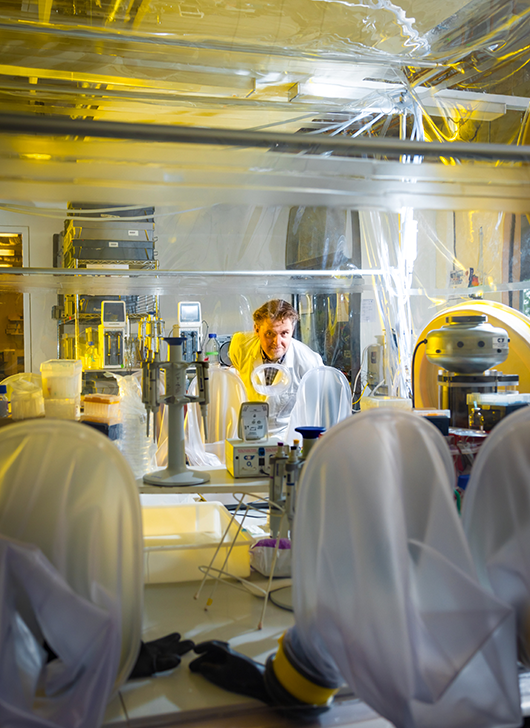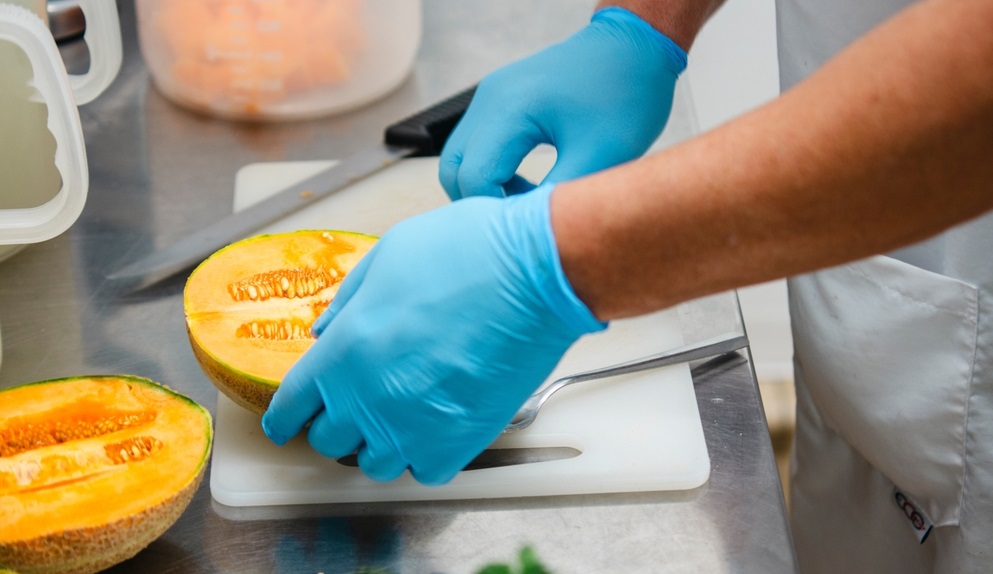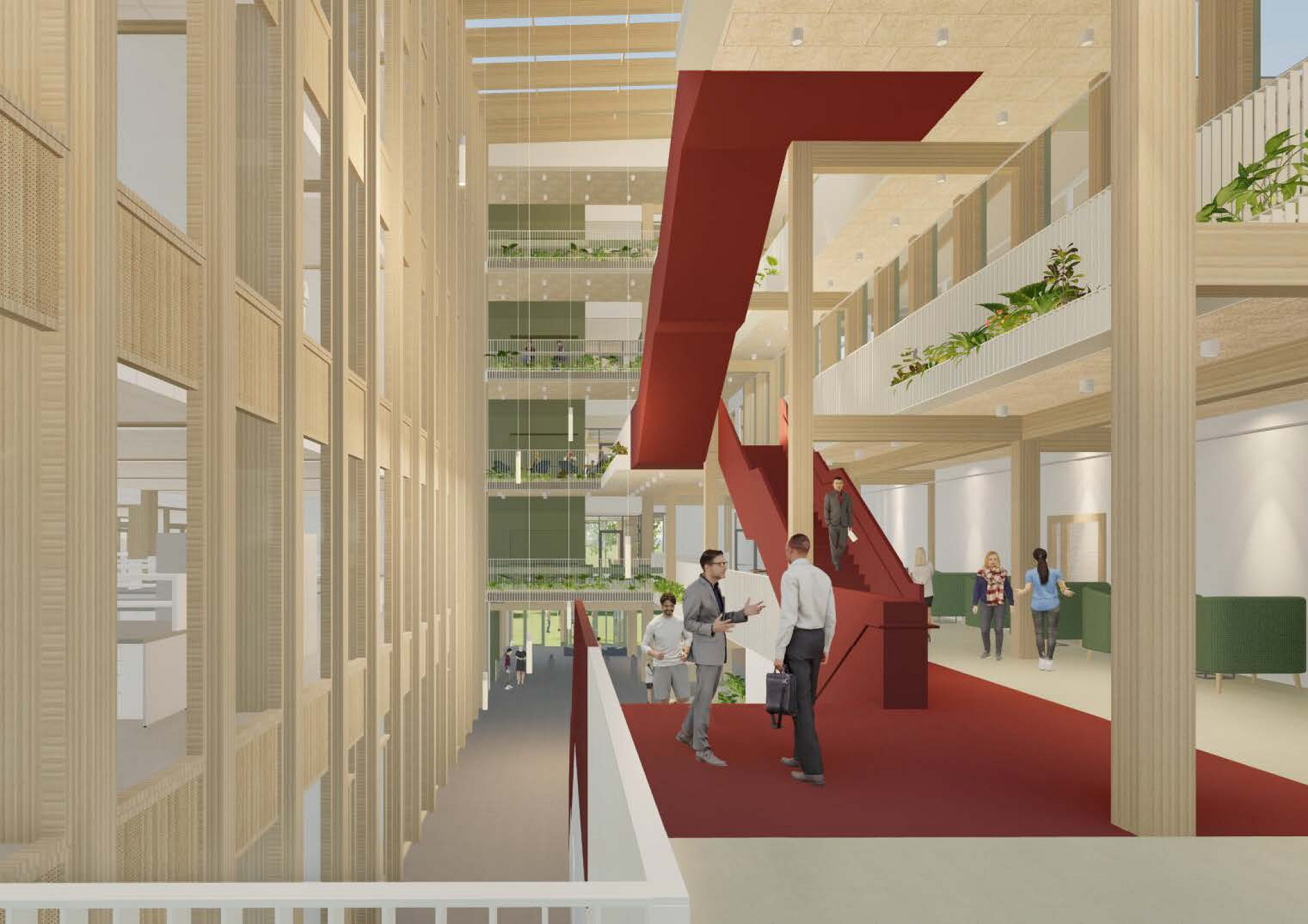In his lab, Thijs Ettema is fitting the puzzle pieces of the ‘tree of life’ together. His research on archaea proves that the classic division of life into three domains can now be discarded once and for all.
Needless to say, it is an advanced lab, this construction on the fourth floor of Helix. But it looks like a transparent tent. And that is indeed what microbiologist Thijs Ettema calls it: an oxygen-free tent. In this anaerobic environment, he breeds archaea, the micro-organisms that made our existence possible. ‘In fact, we are archaea,’ says Ettema. ‘I like to tease my students like that. We humans often consider ourselves to be the pinnacle of evolution. But don’t forget where we came from. We shouldn’t make ourselves more important than we are. Taxonomically, we are just a minor branch of archaea. A little twig on the tree of life.’
Deciphering these origins is what Ettema is working on: the quest to find the origin of the eukaryotic cell – the source of all complex life forms on Earth. In an article in Nature in June this year, he and his team reconstruct the micro-organism that was the last common ancestor of the eukaryotes, which are organisms made up of complex cells with a nucleus. This puts another piece of the puzzle of humans’ ancestry in place. But we’ve got a long way to go, says Ettema. ‘There really is still a big gap to fill between that last common ancestor, an archaeon, an organism without a cell nucleus, and the eukaryotic cell with its nucleus and its specialized cell compartments. It’s a big step from an archaeon to a complex cell.’
Extremophile
Ettema has been professor and chair of Microbiology since 2019. So he has returned to his alma mater, as he studied biology here in the 1990s and got his PhD with John van der Oost in 2005 on a study of archaea before setting up his own research group in this field at Uppsala University in Sweden. His interest in this group of organisms began on the introductory Microbiology course taught back then by Ad van Egeraat. ‘A new world opened up for me.
If you spot something that nobody in the world knows about, that’s as good as it gets
Especially when I heard about extremophilic micro-organisms and archaea. I had never heard of those before. A new domain of life. How come I didn’t know anything about them? Initially, those organisms were mostly found in extreme conditions like undersea volcanoes and hot springs. That seemed very exciting to me and I wanted to research it for my first graduation thesis. And that’s how it all started.’
Under the radar
Archaea were discovered in the 1970s by evolutionary biologist Carl Woese. Archaea are structurally and biochemically different to bacteria, but you can’t tell them apart under a microscope. Each organism is present on Earth in roughly the same numbers, according to Ettema. That archaea have nevertheless remained under the radar for so long is explained by the fact that they are mainly found in inaccessible habitats such as deep-sea sediments. Ettema: ‘In the first genetic analyses, they were found in those environments. But with current sequencing techniques, we are finding them everywhere. Even here on campus.’
A small proportion of all the micro-organisms in the pond at Atlas are Asgard archaea, the group of archaea that Ettema focusses on. He gave them their name, which comes from Norse mythology: Asgard is the home of the gods. All the groups of archaea within the Asgard supergroup have names taken from Norse mythology.
That started in 2015 with the identification of the subgroup of Loki archaea, by means of genetic analysis of deep-sea sediment from Loki’s Castle, a hot spring in the sea between Greenland and Norway.
I’m just a biologist who wants to understand how life works
Based on the genetic material brought to the surface, Ettema reconstructed the first genome of a Loki archaeon, a subgroup of the Asgard archaea. Ettema: ‘The genome turned out to contain many genes that had previously only been seen in eukaryotes. We also proved that Loki archaea are close to eukaryotes in the tree of life.’ That meant they must have a common ancestor somewhere. ‘That was a real eureka moment. This organism told us something about the origin of the first eukaryotic cell.’
Sensation
The paper in Nature caused a sensation in the scientific world. The classic tripartite division of life on Earth (archaea, bacteria and eukaryotes) could be discarded once and for all. We eukaryotes turned out to be a subset of the archaea. So there are not three but two main groups or domains: archaea and bacteria.
Scientists had been questioning the theory of three domains for some time, says Ettema. ‘But our article was the final nail in the coffin. The old hands in the field were not best pleased. Which prompted an editor at Nature to say: “If you have woken up the dinosaurs, you have done a good thing”.’
It is extremely difficult to culture archaea
Ettema has identified many more archaea in recent years. Which is to say, his team reconstructed their genomes. But that doesn’t tell you much about what an organism of this kind looks like. Ettema: ‘We can identify them, map their genes, and even make predictions about their physiology and metabolism on that basis. But we don’t know what they look like. To find that out, you have to grow them in a lab.’ Wageningen’s superior facilities for doing that was one of the reasons behind Ettema’s decision to return in 2019.
Strange tentacles
As it happens, Ettema was too late to be the first to grow an archaeon in the lab. A Japanese group succeeded three years ago. After 12 years of hard work, suddenly there was the first ‘photo’ of a Loki. It was sensational, says Ettema. ‘It looks like no other known organism. Quite small, only half a micron in size. Say, half an E. coli bacterium, with strange tentacles on the outside. No one knows what these are for yet. Last December, a second Loki was grown in Vienna. But we still don’t know what any of the other Asgard groups look like. We are working hard on that in our lab, as are others around the world.’
It is extremely difficult to culture archaea. Not only does it have to be done anaerobically, there is no manual for it either. What conditions should you provide for your archaea, for example? Ettema: ‘You can make predictions about that based on the genes in their genome. For example, we are also working on archaea that produce methane from carbon dioxide and hydrogen. So you have to give them those. But we hardly know anything about most of these organisms. Another variable is the temperature at which they grow best. But the trickiest part is that they grow extremely slowly, taking several weeks to double their numbers. By comparison, an E. coli bacterium divides every 20 minutes. We are trying to grow them using an arsenal of techniques, but it’s still a bit of a shot in the dark. You really need luck on your side.’
Growing
Things are looking good. Inside the tent, a few archaea have started growing, although Ettema has yet to get the group most closely related to eukaryotes to grow. But he is convinced that this will come into view in the foreseeable future. And he hopes that the current results will themselves add a new chapter to the annals of biology. ‘The interesting thing about the group that does grow is that it has a number of eukaryotic genes that are absent in most other Asgard groups,’ says Ettema. But he is cautious. ‘It is still too tenuous and it’s too early for bold claims. But I do think we should abandon the idea that intracellular complexity is exclusive to eukaryotes. It seems that even before their time, there were signs of intracellular complexity.’
Hundreds of newspapers
At the time, the publication on the Loki archaea brought the entire world media hot on his heels. The news made it into hundreds of newspapers worldwide. ‘At some point I had the BBC and National Geographic on the phone at the same time,’ says Ettema. And yet when he got involved in this niche research field, many scientists declared him crazy. ‘Someone even told me at a conference that it was scientific suicide.
Taxonomically, we are just a minor branch of the archaea
Research in the field was at a standstill and tempers sometimes ran high during scientific disagreements at conferences. But I did it.’ And with undeniable success, although that is not his primary motivation. ‘Ultimately, I’m just a biologist who wants to understand how life works. What drives me is the prospect of contributing to that with a small piece of the puzzle. And of course it’s also great if you make waves and find something that leads to amazing new insights. But if you are the first to spot something that nobody in the world knows about at that point – that’s as good as it gets.’
Long haul
Research like Ettema’s is fundamental and therefore hard to get funded. That worries him. ‘This is long-haul research. Nowadays, research has to deliver results quickly and it is often required to have immediate applications. When you apply for a grant, you must already provide a timeframe for when you’ll get results. But that’s not how fundamental research works. It’s crazy, really, that we spend billions on searching for life on planets we will never visit, while we don’t even understand how life originated on Earth. There are only about 300 scientists worldwide in the field of archaea research. Covering an entire domain of life!’
Microbiology
Meanwhile, Ettema leads the chair group as Willem de Vos’s successor. He brought his line of research with him, and it is now the fourth branch of research in the group, alongside bacterial genetics (John van der Oost), microbial physiology (Diana Sousa) and molecular ecology (Hauke Smidt). To make sure he has time for his own research as chair holder, he has appointed an operations manager for administrative tasks. ‘That is still rather new in Wageningen. But if you want to do serious research as chair holder of a large group like Microbiology, it’s the only option. Otherwise you get bogged down in paperwork.’

 Photo Eric Scholten
Photo Eric Scholten 

